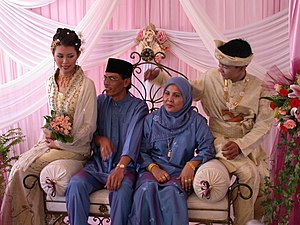
Back Malais singapouriens French Melayu Singapura ID Urang Malayu Singapura MIN Orang Melayu Singapura Malay Malay Singaporeans SIMPLE Малайці Сінгапуру Ukrainian Người Mã Lai tại Singapore Vietnamese 新加坡馬來人 Chinese
| Total population | |
|---|---|
| 545,498 13.5% of Singapore resident population (2020)[1] | |
| Regions with significant populations | |
| Woodlands (25.6%) and Tampines (21.8%)[2] | |
| Languages | |
| Religion | |
| Predominantly Islam 98.8% Minority: Other religions 0.6% • Irreligion 0.4% [3] | |
| Related ethnic groups | |
| Part of a series on |
| Singaporeans |
|---|
Malay Singaporeans (Malay: Orang Melayu Singapura) are Singaporeans of Malay ancestry, including those from the Malay Archipelago. They constitute approximately 13.5% of the country's residents, making them the second largest ethnic group in Singapore.[4] Under the Constitution of Singapore, they are recognised by the government as the indigenous people of the country, with Malay as the national language of Singapore.
At the time of the arrival of British colonial official Stamford Raffles in 1819, the native Malays were the majority living on the island, which at the time had a total estimated population of approximately 1,000.[5] Another estimate placed that at the time of his arrival, the population was 120 Malays, 30 Chinese and some local tribes such as the Orang Laut.[5] From the 19th century until World War II, the Malays enjoyed favourable treatment whereby they were not resettled for labour and their traditional lifestyles were generally left undisturbed.[5] However, as the British needed "coolies",[a] this resulted in particularly lower rates of immigration as compared to the Indians and Chinese, with the latter notably becoming the majority ethnic group by the mid-19th century.[6]
Today, as Singapore is an island within the Malay Archipelago, a significant portion of Malay Singaporeans have their roots from nearby regions such as the Malay Peninsula, Java, Sumatra, Sulawesi and the Riau Islands. This migration has enriched the cultural heritage of the Malay community in Singapore. These groups share the same culture, customs, language, and religion with the broader Singaporean society. They are active in all areas of Singaporean culture and society, with independent representation in fields such as media, politics, and sports.
- ^ Census of Population 2020 Statistical Release 1: Demographic Characteristics, Education, Language and Religion (PDF). Department of Statistics, Ministry of Trade & Industry, Republic of Singapore. 2021. ISBN 978-981-18-1381-8.
- ^ Census of Population 2020 Statistical Release 2: Households, Geographic Distribution, Transport and Difficulty in Basic Activities (PDF). Department of Statistics, Ministry of Trade & Industry, Republic of Singapore. 2021. ISBN 978-981-18-1382-5.
- ^ "20% of Singapore residents have no religion, an increase from the last population census". Channel News Asia. 16 June 2021. Retrieved 17 June 2021.
- ^ "Census of Population 2020|Population" (PDF).
- ^ a b c Lily Zubaidah Rahim; Lily Zubaidah Rahim (9 November 2010). Singapore in the Malay World: Building and Breaching Regional Bridges. Taylor & Francis. p. 24. ISBN 978-1-134-01397-5.
- ^ Saw Swee-Hock (March 1969). "Population Trends in Singapore, 1819–1967". Journal of Southeast Asian History. 10 (1): 36–49. doi:10.1017/S0217781100004270. JSTOR 20067730.
Cite error: There are <ref group=lower-alpha> tags or {{efn}} templates on this page, but the references will not show without a {{reflist|group=lower-alpha}} template or {{notelist}} template (see the help page).
